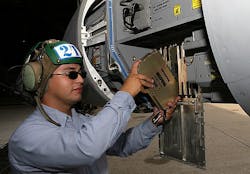Navy awards $41 million contract to Raytheon to provide 15 AN/APG-79 AESA aircraft radar systems
PATUXENT RIVER NAS, Md., 6 Oct. 2014. Radar experts at the Raytheon Co. will provide the U.S. Navy with 15 AN/APG-79 active electronically scanned array (AESA) airborne radar systems under terms of a recent contract.
Officials of the U.S. Naval Air Systems Command at Patuxent River Naval Air Station, Md., announced a $41 million contract to the Raytheon Space and Airborne Systems segment in El Segundo, Calif., for AESA radar systems and related RF and microwave equipment for the Navy's F/A-18 E/F Super Hornet carrier-based fighter-bomber.
The AN/APG-79 AESA radar is for the Navy's Boeing F/A-18E/F fighter-bomber and EA-18G Growler carrier-based electronic warfare jet. It provides aircrew situational awareness, near-instantaneous track updates, and multi-target tracking capability.
The radar enables Super Hornet and Growler crews to fire several missiles at once and guide them to different targets that are widely spaced in azimuth, elevation, or range.
Related: Raytheon and Northrop Grumman to attack costs and complexity of AESA radar
The APG-79 AESA radar uses transmit/receive (TR) modules populated with gallium arsenide (GaAs) monolithic microwave integrated circuits (MMICs). Presumable these are some of the electronic modules that Boeing experts will modify with updated electronics to mitigate obsolescence issues.
The APG-79 radar has an open-systems architecture and rugged commercial-off-the-shelf (R-COTS) parts. Its array has solid-state transmit and receive modules for enhanced reliability, as well as an advanced receiver/exciter, ruggedized R-COTS processor, and power supplies.
The APG-79 AESA radar system, which is in production for the U.S. Navy and Royal Australian Air Force, has become one of the most important enabling technologies for bomber and electronic warfare jets.
Related: Air Force considering AESA radar upgrades for B-1 and B-52 strategic bomber fleets
The radar's active electronic beam scanning helps steer the radar beam at nearly the speed of light to optimize situational awareness and air-to-air and air-to-surface capability, Raytheon officials say. The agile beam enables the multimode radar to interleave in near-real time, so that pilot and crew can use both modes simultaneously.
On this contract Raytheon will do the work in Forest, Miss.; Andover, Mass.; and El Segundo, Calif., and should be finished by November 2016.
For more information contact Raytheon Space and Airborne Systems online at www.raytheon.com, or Naval Air Systems Command at www.navair.navy.mil.

John Keller | Editor
John Keller is editor-in-chief of Military & Aerospace Electronics magazine, which provides extensive coverage and analysis of enabling electronic and optoelectronic technologies in military, space, and commercial aviation applications. A member of the Military & Aerospace Electronics staff since the magazine's founding in 1989, Mr. Keller took over as chief editor in 1995.

